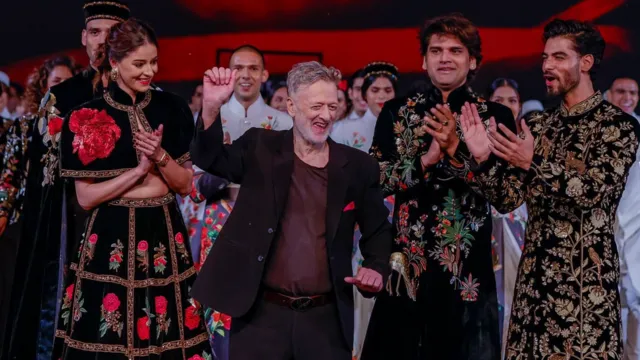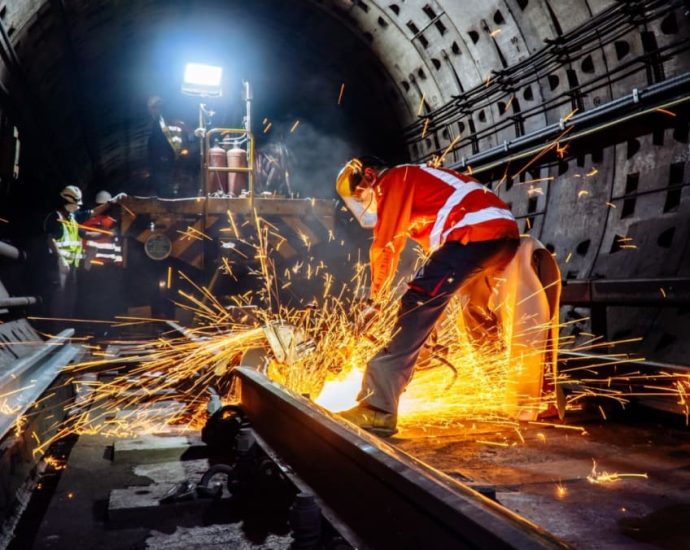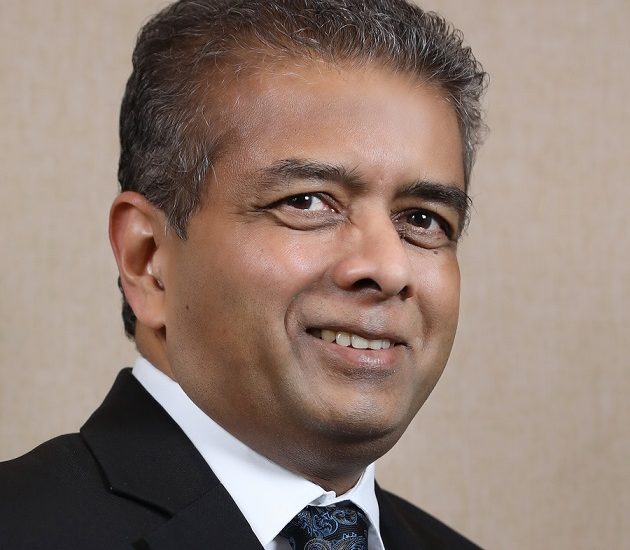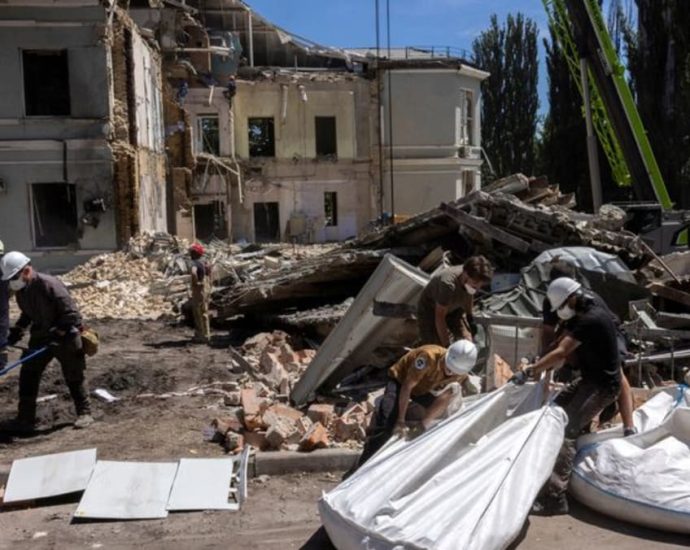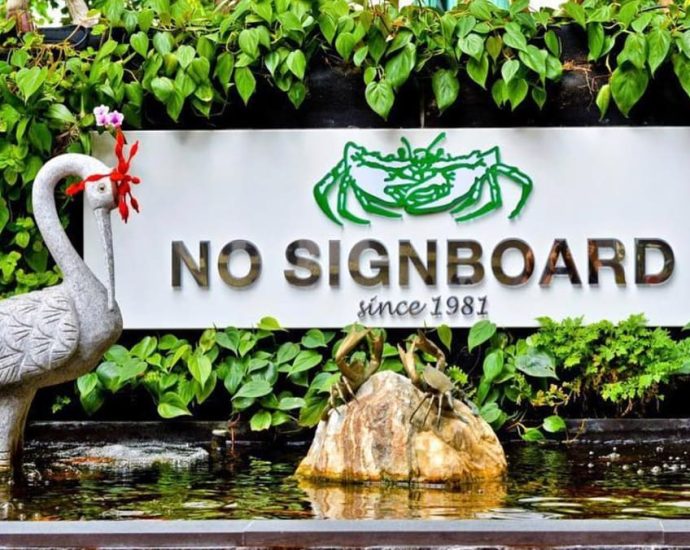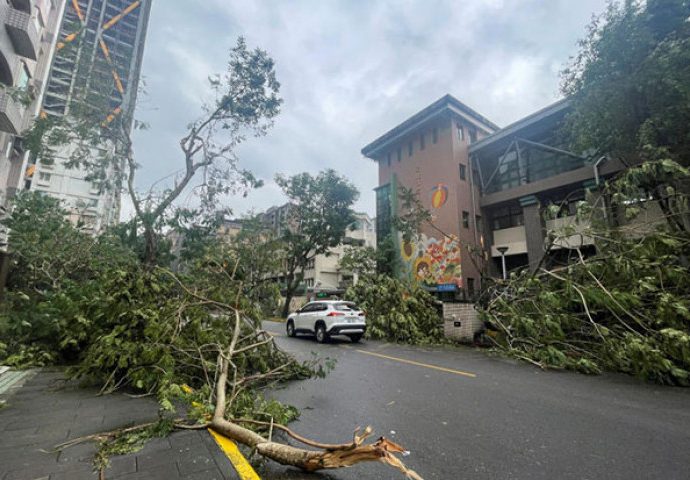Rohit Bal: Pioneering Indian designer dies at 63

 Getty Images
Getty ImagesRohit Bal, one of India’s most celebrated fashion designers, has died aged 63 after a long period of illness.
The Fashion Design Council of India (FDCI) announced his death in a post on Instagram, saying that his work “redefined Indian fashion”.
One of India’s first designers, Bal popularised fashion designing as a viable, glamorous profession in the 1990s and many who came after him credit him for their success.
He had been forced to take a prolonged break due to ill health but made an emotional comeback just weeks ago.
“We will always need a Rohit Bal around to show what classic elegance is – and why it crosses the generational divide,” said an article in The Indian Express newspaper after Bal, looking frail but delighted, appeared alongside his models at the grand finale of the India Fashion Week in October.
Bal’s designs won acclaim for his deep understanding of Indian textiles and meticulous attention to detail.
His innovative creations were worn by Hollywood stars and supermodels and he became synonymous with blending India’s rich cultural heritage with a contemporary flair.

 FDCI/Instagram
FDCI/InstagramBorn in Srinagar in Indian-administered Kashmir in 1961, Bal graduated from Delhi’s St Stephens College with an honours degree in history. He then worked in his family’s export business for a few years, learning the ropes.
After completing his formal education in fashion design at the National Institute of Fashion Technology (NIFT) in Delhi, Bal embarked on a journey that would redefine Indian fashion.
He set up his own label and designer line in 1990 and later opened several stores in India, the Middle East and Europe.

 Getty Images
Getty ImagesOn his website, Bal described himself as a designer who “combines the right mix of history, folklore, village craft, and dying arts to create imaginative and innovative masterpieces for catwalks and fashion talks”.
In 1996, Time magazine listed him as India’s ‘Master of fabric and fantasy’.
Bal’s designs reached far and wide, with Hollywood actress Uma Thurman and supermodels Cindy Crawford, Naomi Campbell and Pamela Anderson wearing his creations. In 2001, tennis star Anna Kournikova walked the ramp for his Paris show.
Best known for his use of lotus and peacock motifs, Bal used rich fabrics like velvet and brocade – his designs were elaborate, inspired by Indian grandeur and royalty.
Apart from designing clothes in his own label, Bal lent his name to endorse products from shoes to linen, had tie-ups with textile giants like the Aditya Birla Group and even ventured into designing jewellery and luxury watches.
He also opened a line for children, saying that he believed that “children are a major consumer class in urban India”.
Bal crafted costumes for the widely-watched Indian game show Kaun Banega Crorepati (Who Wants to be a Millionaire?) and designed costumes for the cabin crew of British Airways.

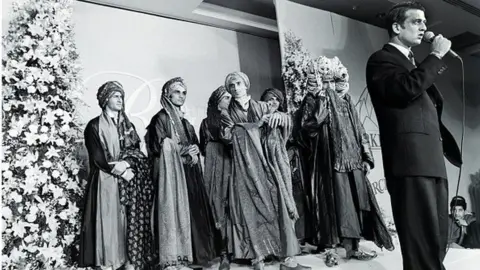 Getty Images
Getty ImagesHe unveiled his inaugural prêt line for online retailer Jabong in 2014.
“I want to separate Rohit Bal from the House of Bal – in products as well as style, in expensiveness and expanse,” Bal told Shefalee Vasudev in Mint newspaper.
“Rohit Bal stores (there will be no prêt here) will be special. People come to me only for special things – they want garments that are like handmade pieces of art. I have it in me to balance the right and left sides of my creative and business leanings.”
When I met Bal years ago in his studio, his characteristic flamboyance was evident in dazzling neon coloured silks embellished with intricate embroidery; sleek blouses and skirts along with taffeta skirts and netted blouses, in bright, warm and cool colours.
“Fabric is the seed of designing a garment, it is the lifeblood of fashion,” he told me.
His earliest memories of fabric were totally sensory, he said, recalling the downy feel of a jamawar shawl at home in Srinagar and the soft warmth of his mother’s shahtoosh saris.

 Getty Images
Getty ImagesHis early years in Srinagar contributed to what he described as a “blissful childhood”. The idyllic life, he said, was disrupted by the violence in the region, compelling the family to relocate to Delhi.
Bal remembered embarking on a sartorial adventure at the age of 11 when he coaxed his father into a tailor’s shop in Delhi to craft his own cowboy pants adorned with tassels.
Bal also diversified into the restaurant business and designed the interiors of one of Delhi’s posh restaurants, Veda, whose opulent and extravagant interiors created a buzz in the Indian media.
He told me it was also okay with him if foreign brands like Armani or Hilfiger came to take up high street space in India.
“They can’t do what I can with Indian designs,” Bal said.
His flamboyant lifestyle prompted the Indian media to call him “the bad boy of fashion”.
“People see me in photographs surrounded by pretty models and think that I am a snobbish, high-maintenance designer who is about beauty and hedonism. When they meet me, they realise how fake that perception is,” he told Vasudev.
SMRT establishes tripartite workgroup to review rail reliability, safety

As part of the review, the workgroup will conduct a peer benchmarking exercise with the Guangzhou Metro Corporation and the Taipei Rapid Transit Corporation.
“This will allow us to exchange insights, and benchmark against the two leading metro operators with world-class safety and reliability records,” SMRT said.
“SMRT remains committed to making continual improvements … for the benefit of our commuters and workers.”
National Transport Workers’ Union executive secretary Melvin Yong said the tripartite approach “takes into consideration the views of all stakeholders to bring about win-win-win outcomes”.
“We look forward to contributing to this review, which also draws on successful practices from regional rail operators.
“With studies showing that unionised companies consistently achieve better workplace safety and health outcomes, it is crucial that we bring forward the perspectives and sentiments of our members, as safety improvements should arise from collaboration at all levels, not solely from the top down,” he said in a Facebook post.
Axiata Group’s Dr Hans Wijayasuriya will relinquish role in Jan 2025 to lead Sri Lanka’s digital transformation
- Spent over 30 years with Axiata and its predecessor, Telekom Malaysia
- Attributes every learning to colleagues, past and present, across Axiata Group
 Axiata Group Bhd announced that Dr Hans Wijayasuriya (pic), CEO of Telecommunications Business and Group Executive Director has been invited by the Government of Sri Lanka (GoSL) to lead the country’s digital economy agenda in the capacity of Chief Advisor to the President on Digital Economy and other related leadership roles.
Axiata Group Bhd announced that Dr Hans Wijayasuriya (pic), CEO of Telecommunications Business and Group Executive Director has been invited by the Government of Sri Lanka (GoSL) to lead the country’s digital economy agenda in the capacity of Chief Advisor to the President on Digital Economy and other related leadership roles.
Wijayasuriya has duly accepted the invitation and has communicated his decision to step down from his role at Axiata Group with effect from 15 Jan 2025. The Board of Directors of Axiata have accepted his decision. During the interim period Wijayasuriya’s responsibilities to Axiata will continue, including the execution of a transition program while he makes himself available for GoSL’s digital transformation initiatives on an advisory and non-executive basis. Axiata will announce any further changes at the appropriate time.
Wijayasuriya has spent over 30 years with Axiata and its predecessor, Telekom Malaysia. A member of Axiata’s Board of Directors in the capacity of Group Executive Director, Wijayasuriya heads the pan-region telecommunications operations of the Group spanning the markets of Malaysia, Indonesia, Bangladesh, Sri Lanka and Cambodia.
Wijayasuriya also served on the Board of Directors of the GSMA, the governing body of the global mobile industry. An active contributor and champion of technology as well as developmental advancements in the mobile industry, Wijayasuriya was honoured with the GSMA Chairman’s Award in 2024, the highest recognition by GSMA, for his outstanding contributions to the global mobile industry.
Sharil Ridza Ridzuan, Chairman of Axiata said “In his 30 years with the Group, Dr Hans Wijayasuriya has been a pivotal force in shaping the company’s strategic direction. He has also played an integral role in nurturing a deep reservoir of talent within the organisation. The Axiata Board congratulates Dr Hans Wijayasuriya on his appointment and is confident that his visionary leadership will contribute to Sri Lanka’s digital future.”
 Vivek Sood (pic), Group Chief Executive Officer and Managing Director of Axiata said, “It is a great honour and source of pride for Axiata that one of our senior leaders has been selected to join the government of Sri Lanka in a highly influential role, contributing to the transformation of the country’s digital economy. His extensive expertise in telecommunications, technology transformation, and digitisation will bring tremendous value to Sri Lanka.”
Vivek Sood (pic), Group Chief Executive Officer and Managing Director of Axiata said, “It is a great honour and source of pride for Axiata that one of our senior leaders has been selected to join the government of Sri Lanka in a highly influential role, contributing to the transformation of the country’s digital economy. His extensive expertise in telecommunications, technology transformation, and digitisation will bring tremendous value to Sri Lanka.”
Vivek noted that Wijayasuriya has been instrumental in advancing Axiata’s Telco-TechCo agenda and strengthening its portfolio with the aim of delivering long-term value to shareholders.
Wijayasuriya, said, “It has been an honour and privilege to be part of Axiata’s journey over the past decades. I am honoured by the invitation extended to me by the Government of Sri Lanka, and I stand privileged to have the opportunity to contribute to my country. As I embark on this new chapter, I am deeply aware that every learning I possess, I owe to leadership and colleagues, past and present, from across the Axiata Group. To them, I will always be grateful.”
Govt picks U Mobile to implement Malaysia’s second 5G network
- MCMC said it ran rigorous technical and commercial processes on all bids
- With MCMC nod, U Mobile can collaborate with other MNOs in implementation

The Malaysian Communications and Multimedia Commission (MCMC) has announced U Mobile Sdn Bhd as the winning party to implement Malaysia’s second 5G network.
MCMC said it has rigorously undertaken processes encompassing detailed deliberations on technical and commercial aspects, before settling on UMobile as the mobile network operator (MNO) to implement the second 5G Network after Digital Nasional Bhd.
U Mobile, subject to the approval of MCMC, is allowed to collaborate with other MNOs in the implementation of Malaysia’s Second 5G Network.
This leaves the door open for Maxis Bhd to possibly acquire UMobile as some media have reported in Sept. U Mobile reported 9 million subscribers at the end of 2023. Maxis reported 12.75 million subscribers at the end of Q2 2024.
MCMC said will continue to oversee the progress of the implementation of Malaysia’s Second 5G Network to ensure total compliance with all regulatory requirements as provided for in the Communications and Multimedia Act 1998 (Act 588).
Five Singapore-based firms sanctioned by the US for enabling Russia’s war effort

UNILATERAL, BUT CARRY WEIGHT
“Unlike United Nations’ sanctions, US sanctions are unilateral,” explained S Rajaratnam School of International Studies research fellow Muhammad Faizal Abdul Rahman.
“But they carry significant weight as the US is the largest economy in the world by GDP (gross domestic product) and it is the global power that dominates the international financial system.”
He said that foreign firms under US sanctions would find it difficult to do business with American entities or individuals, and sell or procure goods and services from the US market.
Such sanctions would also isolate these companies from the international financial system, said Mr Faizal.
“These sanctions could also function as indirect political pressure on other countries, especially those in the non-western world, to do more to rein in the sanctioned companies and be more aligned with the West in efforts to weaken the Russian economy and military-industry complex,” he said.
Dr Shashi Jayakumar, executive director of security consultancy SJK Geostrategic Advisory, noted that this is not the first time that Singapore entities or individuals have been designated under the OFAC sanctions list.
“Singapore entities and individuals have been designated under OFAC in the past on account of their links with, or dealings with, North Korea, Iran or Myanmar,” he said.
In March 2022, Singapore imposed financial measures targeted at designated Russian banks, entities and activities in Russia, as well as fundraising activities benefiting the Russian government.
The Singapore government also imposed export controls on items that can be “directly used as weapons to inflict harm on or to subjugate the Ukrainians”, as well as items that can contribute to offensive cyber operations, the Ministry of Foreign Affairs said then.
Former No Signboard Holdings CEO fined S$420,000 for false trading

SINGAPORE: The former executive chairman and CEO of restaurant operator No Signboard Holdings was fined S$420,000 (US$317,000) on Friday (Nov 1) for price rigging offences.
Lim Yong Sim pleaded guilty to three charges of false trading, said the Singapore Police Force (SPF) in a news release on Friday.
In June 2018, Lim purchased 4,331,200 No Signboard shares using the trading account of Gugong Pte Ltd. This was to falsely push up No Signboard’s share price.
“Lim was then the director and majority shareholder of Gugong, which was in turn a majority shareholder of No Signboard Holdings,” said SPF.
The police added that at the material time, Lim was under pressure from shareholders due to No Signboard’s declining share price.
The false trades lifted No Signboard’s share price by 27 per cent, from S$0.154 to S$0.196, against the backdrop of a decline of 1.69 per cent in the Straits Times Index during the same period.
The restaurant operator’s share price fell again afterwards, following the announcement of its 2018 financial year results. No Signboard’s share price fell to S$0.137 after the results announced on Nov 29 revealed that it had registered a loss.
A day after the announcement, Lim began trading in No Signboard shares again.
Between Nov 30, 2018, and Jan 11, 2019, he bought 3,535,100 shares using Gugong’s trading account. These trades were aimed at cushioning the fall of the restaurant operator’s share price.
“Lim’s trades supported No Signboard share price at around S$0.140 between Nov 30 and Dec 21, 2018, and at around S$0.130 between Jan 3 and Jan 11, 2019,” said SPF.
He also used No Signboard’s corporate share buyback account for “similar manipulative trades” on Jan 31, 2019, added the police.
Lim purchased 1,068,700 No Signboard shares the day before the release of the restaurant operator’s financial results for the first quarter of the 2019 financial year. The restaurant operator had again recorded a loss.
Lim’s trades were to “cushion the selling pressure that would likely follow from the imminent announcement”, said SPF.
The purchases were made above the price limit of No Signboard Holding’s share buyback mandate and raised its share price by 15.7 per cent over the previous day’s close.
“This far exceeded the movement in the STI, which rose only 0.50 per cent that day,” said the police.
Lim was arrested in April 2019 due to suspicions that he had breached sections under the Securities and Futures Act. He was charged in July last year for price rigging offences.
After his charging, No Signboard Holdings announced that Lim was suspended from all his executive duties.
Capital equipment not enough to revive US chip-making – Asia Times
After decades of decline, a new boost in US manufacturing is garnering considerable media attention. In particular, the semiconductor industry has been prioritized for US government support through the CHIPS Act initiative with some US$50 billion worth of state funding.
But what will be needed to increase and sustain US high-technology manufacturing? A serious resurgence of advanced manufacturing (chips being the most demanding) will require much more than investing in more sophisticated equipment in new plants.
It will require training a new generation of highly skilled personnel to operate such plants successfully. While increasingly sophisticated technology is key to much of competitive manufacturing, it is productive only with staff with very specialized training to operate in complex plant environments. Badly managed mechanization will hinder rather than promote value creation.
I learned from experience in semiconductor manufacturing. Early in my career at RCA, I was tasked with designing and operating one of the first silicon transistor factories to manufacture the 2N2102, a transistor I had developed for use in building computer and other electronic systems.
I outfitted the factory with equipment scaled from my laboratory. At the time, no commercial production equipment existed. For example, the optical lithographic equipment was built by the local photography shop in Somerville, New Jersey, for a few hundred dollars.
When production volume needed to increase, new equipment was required and we purchased new, more automated commercial production equipment then coming to market. I had hoped that such equipment would increase production volume and yields.
However, volume increased but product yields declined. The cause, we discovered, was inadequate process definition for the automated equipment.
We found that with the original manual processes, the production technicians introduced changes as they deemed necessary to maintain quality and production rates in the face of small changes, for example, in the temperature of chemical solutions.
The new machines were designed to operate under fixed pre-set conditions and changes were not automatically adjustable. To make the factory operate, we had to invest time and effort in defining all of the production elements and avoid human intervention randomly introduced to correct anomalies.
The machines had to be programmed with great precision for desired results. This required much process research to understand variables.
Here, I learned a valuable lesson in production management—the importance of very precise process definition and control. As new, more automated equipment was introduced, product yields frequently declined initially.
They did not improve until the production process was refined to new levels because new automated equipment required new levels of process knowledge and control.
To enable successful production required a close working relationship between production process engineers and equipment operators. These engineers had to be trained to fully understand the technology. This was a new engineering discipline.
This necessitated change in production methodology was costly and hard to accept by production managers trained in the old days of low levels of automation. But change they did as a new generation of production managers entered chip manufacturing.
However, I found that, given the same equipment, plant performance was a strong function of local management quality and staff training. The variables to be controlled and adjusted with automation were practically endless and the plants had to develop their own process engineering skills to perform economically.
In effect, starting with devices designed in the laboratory, moving them into production was a whole new endeavor requiring talent as valuable as that of the original design team.
It is evident that as chips increased in complexity, production became extraordinarily demanding in capital and human resources. For my original transistor, the device dimensions were in fractions of a centimeter and a photoshop could make the equipment to form the dimensions.
Today, integrated circuit chips have billions of transistors interconnected with dimensions approaching atomic ones. Whatever challenges I faced, today’s plants have them in far greater complexity and cost.
Fast-forward to 2024, and my simple homemade lithographic tool has evolved for the most sophisticated chip production to a huge piece of ultraviolet laser-powered equipment produced by ASML (the sole producer globally), which sells for about $300 million and requires specially trained staff to operate.
Faced with such costs and management challenges, it is easy to understand why the leaders of so many chip companies decided that manufacturing was too challenging and outsourced production to Taiwan’s TSMC, which is exclusively committed to chip manufacturing.
TSMC’s success is not based on the invention of unique equipment. Rather, it is rooted in outstanding management of human and capital resources. The company trains its staff to a high level of performance and operates its plants to get the best possible performance from its costly equipment.
A new fully equipped plant costs $20 billion but it is the highly trained management and staff that make it work. At this time, TSMC produces over 90% of the highest-performance chips in the world. Anyone looking to compete has to invest in the human resources needed, not just the equipment.
Henry Kressel is a technologist, inventor, author and industry executive. He is a long-term private equity investor in technology businesses. Incidentally, the original 2N2102 product is still commercially available.
Worker’s distraught family pleads for return of body from Israel
Buri Ram father of three had gone to northern Israel danger zone for higher wages

BURI RAM – The family of one of the four Thai workers killed by rocket fire in Israel was saddened by the death and hopes to see his body returned soon for a religious ceremony at home.
The atmosphere was solemn at the house of Prayad Pilasrum in Nong Phluang village in Krasang district on Friday after his parents and were informed about his death. Their neighbours stopped by to give them moral support and offer them blessing threads.
His wife, Prapai, said she was in shock and could not cope with the sudden loss of the breadwinner of the family.
His elder sister Sulaporn said the family wanted Israel to send the body back as soon as possible for funeral ceremonies and to provide financial compensation.
Prayad, 42, is survived by his wife and three children. He was one of the four Thai workers killed by rocket strikes fired from Lebanon to the border town of Metula on Thursday.
The Thai embassy in Tel Aviv identified the other victims as Akkraphol Wannasai, a native of Udon Thani, Thana Tichantuek and Kaveesak Papanang of Nakhon Ratchasima. Another labourer was injured and his name was not released.
Prayad had made a living by driving a song thaew but decided to seek his fortune overseas after the Covid-19 pandemic which left him and family with little money. Friends in the village had talked about working in Israel and he decided to go.
His mother secured a loan from the Bank for Agriculture and Agricultural Cooperatives and more from loan sharks, totalling more than 100,000 baht, to pay for travel and other expenses.
Prayad left for Israel in December 2021 but was among the more than 8,000 Thai workers who returned in October last year after the Hamas attack on Israel led to the war that continues today.
Ms Prapai said her husband’s employer in Israel later contacted him about returning to work to complete his contract. He went back and was working in central Israel but his colleagues talked him into moving to work in the dangerous northern area because of higher wages.
She said the family disagreed with his move but her husband wanted to take the risk to earn more money.
His wife did not say when he left for the second trip back to Israel.
Typhoon Kong-rey kills one Thai in Taiwan

One Thai was killed in a car accident during the super typhoon in Taiwan, according to the Foreign Ministry.
Ministry spokesman Nikorndej Balankura said on Friday that the ministry was informed by the Thailand Economic and Trade Office in Taipei that one Thai worker died in a car accident in Nantou city due to the impact of Typhoon Kong-rey, one of the biggest typhoons to hit the island in decades. The deceased was identified as Rungsini Hothiwong. She was from Sukhothai.
He said the Thai office contacted the Labour Ministry and local authorities in Thailand to inform the family of the deceased and has informed them about compensation.
Trump 2.0 would be no easy ride for Vladimir Putin – Asia Times
MOSCOW—Many American elites, their media allies and card-carrying Democrats are convinced that a second Trump presidency would present Vladimir Putin with only opportunities. The reality is that a Trump 2.0 administration would likely bring more problems than the Russian leader has at present.
This soft-on-Putin narrative stems from the “Russiagate” conspiracy theory alleging that Trump was either a full-blown Russian agent or easily manipulated by Putin during his first term. Check the record, though, and it’s clear that Trump imposed more sanctions on Russia than any US president before him until Joe Biden.
Trump failed to implement campaign pledges to improve ties with Russia due to the pressure applied on him by the Russiagate accusation and the way in which some permanent members of the US military, intelligence, and diplomatic bureaucracies, spelled “deep state”, subverted his policy vision.
Trump also bombed Syria early in his presidency in response to what Russia considered to be a false flag chemical weapons provocation, which Barack Obama balked at doing in 2013 and thus called Russia’s bluff from back then.
Another irritant in bilateral ties was the sanctions that Trump imposed on the Nord Stream II pipeline, motivated by his bid to poach the European energy market from Russia for American producers.
Russia was also displeased that Trump did nothing to encourage France, Germany and Ukraine to implement their obligations under the Minsk agreements to resolve the conflict between Ukraine and Russian-backed separatists in the Donetsk and Luhansk regions of eastern Ukraine.
These and other issues caused Russia to regard Trump’s first presidency as a lost opportunity to enter into a meaningful rapprochement and to be bitter about it in hindsight.
Biden’s term was much worse for bilateral relations, but it didn’t start that way. Biden and Putin met in Geneva in June 2021, shortly after the US leader waived Trump’s sanctions on Nord Stream II, following which Putin publicly defended his American counterpart’s cognitive state in response to a question about them.
But anti-Russian “deep state” hawks ultimately preferred prioritizing Russia’s containment over China’s, sustaining America’s security dilemma in Europe. Putin’s security guarantee requests from December 2021 were rejected, which set into motion the events that would lead to his decision to launch his “special military operation” in Ukraine in February 2022.
It’s beyond the scope of this analysis to rehash the run-up to that fateful decision, but it’s sufficient to say that the events that followed have completely changed the nature of Russia-US relations. If Trump returns to office, he’ll inherit a much more difficult bilateral situation than he did during his first tenure.
The precedent set by his inability to prevent anti-Russian “deep state” hawks from subverting his envisaged rapprochement bodes ill for his possible second term from Moscow’s perspective, considering the much greater power these officials now wield over policymaking on all Russia-related matters.
Russia’s fears that they could stage a major provocation for escalating the Ukraine conflict if Trump wins, whether before or after he’s reinaugurated, explain why Putin endorsed Biden and then Kamala Harris.
Contrary to his image in the Western mind, Putin is a very cautious leader who considers himself the consummate pragmatist. That explains why he only authorized conventional military interventions in Syria and Ukraine at what he thought to be the last possible minute before perceived windows of opportunity closed.
He’s even been constructively criticized by nationalistically minded Russians and their supporters abroad for waiting too long with both military interventions, arguing they might have been more successful had they had been launched earlier.
Putin’s endorsements of Biden and then Harris weren’t part of some “5D chess master plan”, like some have speculated, but rather were sincere reflections of his preference for dealing with the proverbial devils that he already knows than a return to Trump uncertainty.
Not only might Russia fear that the “deep state” could stage major provocations to subvert Trump’s stated plan for ending the Ukraine war within months of taking office, but Trump himself might flirt with “escalating to de-escalate” on his own.
These same “deep state” forces have wisely applied a “boiling the frogs” approach to the latest phase of the already over-decade-long Ukrainian conflict by gradually escalating US involvement and always signaling such in advance so that Russia could prepare and not overreact.
This managed warfare has helped Russia and the US manage their worsening security dilemma caused by American mission creep in the conflict, thus avoiding an apocalyptic World War III scenario sparked by miscalculation – at least up until now.
That could change if Trump is re-elected, at least from Russia’s perspective, since either he or the “deep state” could ignore these prior guardrails by escalating to de-escalate in very dangerous ways. The purpose would be to coerce concessions from Russia ahead of a seemingly inevitable grand peace deal.
Putin has staked his reputation on at least obtaining control over the entirety of the four former Ukrainian regions that Russia now claims so he will be very reluctant to freeze the conflict before that is secure on the battlefield.
Perhaps a series of mutually acceptable compromises between Russia and the US (which could coerce Ukraine into complying with whatever Washington agrees with Moscow) might be reached under Trump. But even if the “deep state” doesn’t subvert such a deal, other problems might quickly arise for Russia.
If the aforementioned compromises aren’t paired with sanctions relief for Russia, then Trump might revert to his preferred use of these means to pressure India, Turkey, the UAE and others into sanctions compliance to Russia’s detriment.
His well-known dislike of Iran could also see him repeat his prior “maximum pressure” policy against Tehran at the expense of Russia’s efforts to develop the North-South Transport Corridor (NSTC), which runs through Iran and connects Russia with the Gulf States, India and further afield to Africa and Southeast Asia.
In that scenario, Russia would risk becoming even more disproportionately dependent on China than it arguably already is, which it has sought to hedge and avert by using India as a counterweight in various ways.
A Trump 2.0 presidency would only present opportunities for Russia if none of those three scenarios – “escalating to de-escalate”, doubling down on sanctions enforcement, and choking off the NSTC – transpires, a fair compromise ends the Ukraine war and the US “Pivots (back) to Asia” and out of Europe pronto.
Trump’s plan for NATO, as reported by Politico, could enable Russia to more effectively manage their security dilemma in Europe with a view toward negotiating a new security architecture there.
American troops could thus be freed up for redeployment to the Asia-Pacific to contain China, shifting the center of the New Cold War to the other side of Eurasia and relieving some of the pressure applied on Russia over the past two and a half years.
Moreover, encouraging the Europeans to take more responsibility for their own security could lead to a thaw of sorts in their ties with Russia, as would the lifting of some sanctions.
US prioritization of China’s (and to a lesser extent Iran’s) containment over Russia’s in a second Trump presidency would relieve pressure on Russia in Europe, though at the cost of creating new problems that might threaten its interests further afield.
The heightened risk that a hot war could break out by miscalculation between the China and the US, or at least between China and some of the US’ top regional partners like Japan, the Philippines, and/or Taiwan, would destabilize the world much more than the Ukrainian conflict has over the past two and a half years.
That’s because the Asia-Pacific is the center of global economic growth, and a major conflict there would likely disrupt key supply chains. This is especially so for the tech sector, specifically with regard to the high-end chips that power the so-called “Fourth Industrial Revolution” as well as state-of-the-art military equipment, thus limiting Russia’s supply even more than currently due to US-led sanctions and raise the risk it falls further behind peers and rivals.
Even if a hot Asia war is avoided and supply chains remain intact, Trump would be expected to apply tremendous pressure on Russia to distance itself from China, perhaps through a carrots-and-sticks approach of the sort that he implied during his live interview with Tucker Carlson on Thursday night during a fundraiser in Arizona.
At the event, Trump claimed that Biden “allowed them (China and Russia) to get together. It’s such a dangerous thing. The stupidity of what they have done… I’m going to have to un-unite them, I could do that too.”
Considering the trade war that Trump waged against China during his first term and his explicitly declared goal of ending the Ukraine war “as soon as possible” if he’s re-elected, Trump might try to meld the two initiatives to “un-unite” China and Russia as part of a new divide-and-rule strategy.
This could put Russia in a dilemma of either accepting whatever deal Trump might propose at the expense of reversing some of the bilateral progress made in with China since 2022, or rejecting it at the cost of Trump dangerously escalating to de-escalate in Ukraine with the potential for a hot war with the US and associated miscalculation risks.
Cautious and pragmatic Putin might thus prefer to retain the presently more predictable trajectory of US-Russian ties in the New Cold War under Harris than risk a new era of global uncertainty under Trump.
Andrew Korybko is a Moscow-based American political analyst who specializes in the global systemic transition to multipolarity. He holds a PhD in political science from the Moscow State Institute of International Relations.” Follow him on X at @AKorybko

